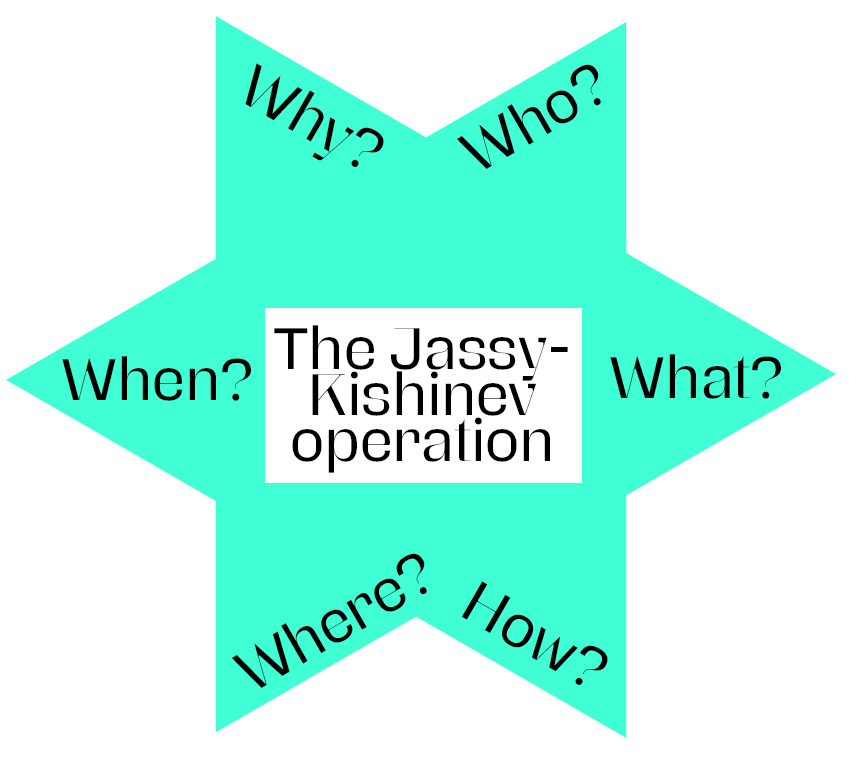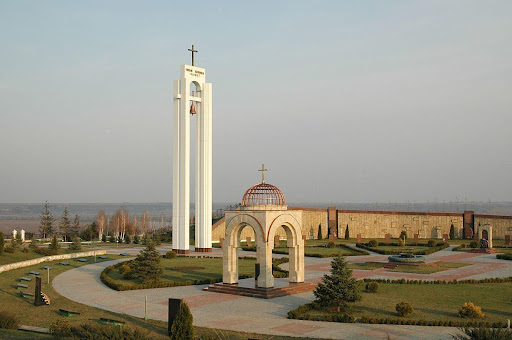This website uses different cookies. We use cookies to personalize content, provide social media features, and analyze traffic to our website. Some cookies are placed by third parties that appear on our pages. You can find more information and options to choose from in our Privacy Policy and Configurations for usage.
- Learning activity
- Learning outcomes
- Pedagogical Recommendations
- Preparation Activities
- Visit Activities
- Glossary
- Appendices
- Appendix I – Information about the Jassy-Kishinev operation
- Appendix II – The Șerpeni Bridgehead Memorial
- Appendix III – Monument observation worksheet
- Appendix IV – Photo quest
- Appendix V – Questions for reflection
- Download guide
World War II memorials from the perspective of the Șerpeni Bridgehead Memorial
Вікторыя Піла ліцэй Праметэй-Прим, Кішынёў, Малдова / Александру Сеу Тэарэтычны ліцэй ім. Міхая Эмінеску, Единец, Рэспубліка Малдова
15+ гадоў
45 min preparation + 120 min visit (travel time not included)
Key question: Why might a World War II monument be constructed 60-70 years after the war?
* Kishinev is the city now known as Chișinău; the official English name for the military operation is ‘the Jassy-Kishinev operation’, and this official name will be used throughout when referring to the operation.
Learning outcomes
Students will:- Learn the significance of the Jassy-Kishinev operation during World War II
- Identify several types of historical monument in a complex such as the Serpeni Bridgehead and describe their significance
- Learn the influence of local geographical factors on historical events
- Train their understanding of historical concepts such as continuity and change, cause and consequence, through the study of historical monuments
Pedagogical Recommendations
The teacher should bear in mind that this lesson is designed as part of the World War II curriculum and covers the radical turn of events exemplified by the advance of Soviet forces in South-Eastern Europe in August 1944. The teacher should incorporate relevant information about this topic. It is important to mention that people from the territory of the Republic of Moldova fought on both sides: the Soviet Army and the Axis Powers.Students will learn about the Jassy-Kishinev operation in class. The bus ride to the destination will be used by the teacher to explain details of the troop movements and to form working groups in the field. During the visit they will receive tasks to discover various monuments and their significance, reflecting on the importance of historical sites. Students will complete a monument observation sheet, then they will work in small groups for a photo quest activity, and finally they will answer some questions.
It is important to mention that the monument is recent, so students need to understand that history is still being made today through research, for example recent excavations have uncovered unidentified remains of soldiers.
Preparation Activities
Stage 1: Learning about the Jassy-Kishinev operation. 15 minutesStudents should read the text about the Jassy-Kishinev offensive operation and study the map (see Appendix I). Using the information they learn, they should complete the star chart. The teacher can either project the chart or draw it themselves on the board.

Stage 2: Comparison of answers. 10 minutes
In groups of 3, students compare answers to the star and try to understand any differences.
Stage 3: The memorial site. 15 minutes
In groups of 5, students read the description and study the photos of the site (see Appendix II), and try to answer the following questions:
- Why do you think the complex was only opened in 2004?
- Why do you think people from different countries financially supported this project?
- Why was Șerpeni considered a “strategic bridgehead” by the Soviet Army?
Stage 4: Preparation for visit. 10 minutes
At the end of the preparatory lesson, the teacher should give instructions on what will happen during the visit and how students are supposed to behave.
Visit Activities
Stage 5: Exploration and Observation. 75 minutesAt the memorial site, students will be given free rein to walk around and explore. Each student will complete a monument observation sheet during the visit (see Appendix III). As a group, students should explore the territory of the memorial site and carry out a photo quest (see Appendix IV). The teacher should be present to prompt and answer any questions the students might have. If possible, a guide should give a short tour.
Step 6: Reflection. 15 minutes
The reflection sheet should be completed by each student after the trip (see Appendix V). In groups of 3, students should compare and discuss their answers to the reflection sheet either before getting on the bus home, or in the classroom in a following lesson. Photos taken during the visit can be used on the school's official website or in a subsequent summary lesson.
Glossary
Here you can find definitions for the words in bold below.- Axis Powers – the coalition led by Germany, Italy, and Japan during World War II. They opposed the Allied Powers, consisting mainly of Great Britain, France, the United States, the Soviet Union, and China.
- Bridgehead – a strategically important area of ground around the end of a bridge or other place of possible crossing over a body of water.
- Red Army – the army and air force of the Soviet Union during World War II.
- Stalin’s ten blows – the ten successful strategic offensives conducted by the Red Army in 1944 during World War II.
Appendix I – Information about the Jassy-Kishinev operation
The Jassy-Kishinev operation was part of the Soviet offensive in 1944 on the Eastern front, also named The Battle for Romania, included by Soviet leader Joseph Stalin as part of his ‘ten blows’. The first offensive in the area was part of Stalin’s strategy of projecting Soviet military power and political influence into the Balkans in April – June 1944.The second offensive in August, named after two major cities, Jassy (Romania) and Kishinev (Chișinău, Republic of Moldova) was a Soviet offensive against the Axis forces. The operation entailed prolonged heavy fighting on the current territory of the Republic of Moldova. The offensive resulted in the encirclement and destruction of the German forces, allowing the Red Army to resume its strategic advance further into Eastern Europe. For the Germans, this was a massive defeat, comparable to the defeat at Stalingrad. Other results of this battle were the removal of Romania from the war and its joining of the Allies, and the re-annexation of territory between the rivers Dniester and Prut by the Soviet Union, which lasted for another 47 years.
On 23 August 1969, on the 25th anniversary of the Jassy-Kishinev offensive, a liberation monument at the Academy of Science of Moldova was opened. It has since been renovated three times, in 1975, 2014, and 2019. A second monument in the village of Chitcani was opened on 9 May 1972 and is currently on the site of a mass graveyard, where 1,495 soldiers who died during the operation are buried.
The Serpeni Bridgehead Memorial was opened in 2004. The complex was built to commemorate the 60th anniversary of the liberation of Moldova from fascist rule, in memory of the Soviet soldiers who died during the Jassy-Kishinev operation. Two years later, on 9 May 2006, after restoration, the Eternity Memorial Complex in Chișinău was reopened, acting as the main Soviet war memorial in Moldova.
Source: Adapted from ‘Second Jassy–Kishinev Offensive’, Wikipedia, accessed 11 July 2022.

Appendix II – The Șerpeni Bridgehead Memorial
Location: Șerpeni, Anenii Noi district, Republic of MoldovaDescription: 70 km east of Chișinău, on the right bank of the Dniester River, one can find a special memorial of historical and national importance, which was erected in memory of the heroes who died during the Jassy-Kishinev operation of 1944 to free Chișinău from fascist occupation. The Șerpeni battle was one of the cruellest in World War II even if it represented just a small episode of the war.
The memorial was erected on the site of a strategic bridgehead on the high right bank of the Dniester, which was liberated by troops of the 2nd and 3rd Ukrainian Fronts of the Red Army. In 1985, according to witnesses, a mass grave of Soviet soldiers was found in the village of Șerpeni. In October 1985, the authorities of the Republic of Moldova decided to build a memorial to the military victory at the site, and to rebury the remains of these Soviet soldiers.
A competition to design the memorial was held and the winner was the architect Leonid Grigorashchenko. The construction of the memorial complex was carried out between 1995 and 2003. Dozens of people from Russia and Ukraine provided substantial support during the finalisation of the construction. On 22 August 2004, the memorial complex was opened by the architect S. Shoikhet and sculptor S. Ganenko. The official inauguration ceremony was attended by veterans from the Republic of Moldova, Ukraine, Russia, Uzbekistan, Kazakhstan, Belarus, and others. A year later, a veteran delivered a speech at the complex in which he compared it to the Mamayev Kurgan in Volgograd and the Brest Fortress in Belarus.




Appendix III – Monument observation worksheet
| Analysis criteria | Student's notes |
| Geographical/physical context: Describe the location of the monument, the surrounding encironment and geographic context, including landmarks and/or topographical information. |
|
| Site description: Describe the size, general layout, spatial organisation, etc. of the site. |
|
| Description (exterior or surface features): Describe the monument's structure, form, stlye, materials, etc. |
|
| Specific details: Include some specific insctriptions, photos, internet references. |
Appendix IV – Photo quest
Walk around the memorial complex. Find and take photos of the following parts. Describe them in detail and explain what they contribute to the site.*Arc of Glory
Description:
Mausoleum with Eternal Flame
Description:
Chapel of Pain
Description:
Tomb of the Unknown Soldier
Description:
A specific cross in the cemetery (your choice)
Description:
* Note: these are specific to the Șerpeni Bridgehead Memorial; change them if you are using this exercise for a different monument.
Appendix V – Questions for reflection
| What objectives did I set for this visit? |
|
| How did experiencing the memorial site compare to studying it in class? |
|
| How did I feel during the visit? |
|
| What goals were pursued by the decision-makers when building this monument? |
|
| Is this memorial site relevant to me as a young citizen of Moldova? |
|
| Are monuments an important part of history today? |
Download guide
Дадатковыя
матэрыялы
ўрока
Пачатак і заканчэнне Другой сусветнай вайны
Дзеці ў гады Другой сусветнай вайны
Памяць і мемарыялізацыя Другой сусветнай вайны ў розных краінах
Гвалтоўны ўгон моладзі на працу ў Германію падчас Другой сусветнай вайны
Змена дзяржаўных межаў у выніку Другой Сусветнай вайны
Наступствы Другой сусветнай вайны